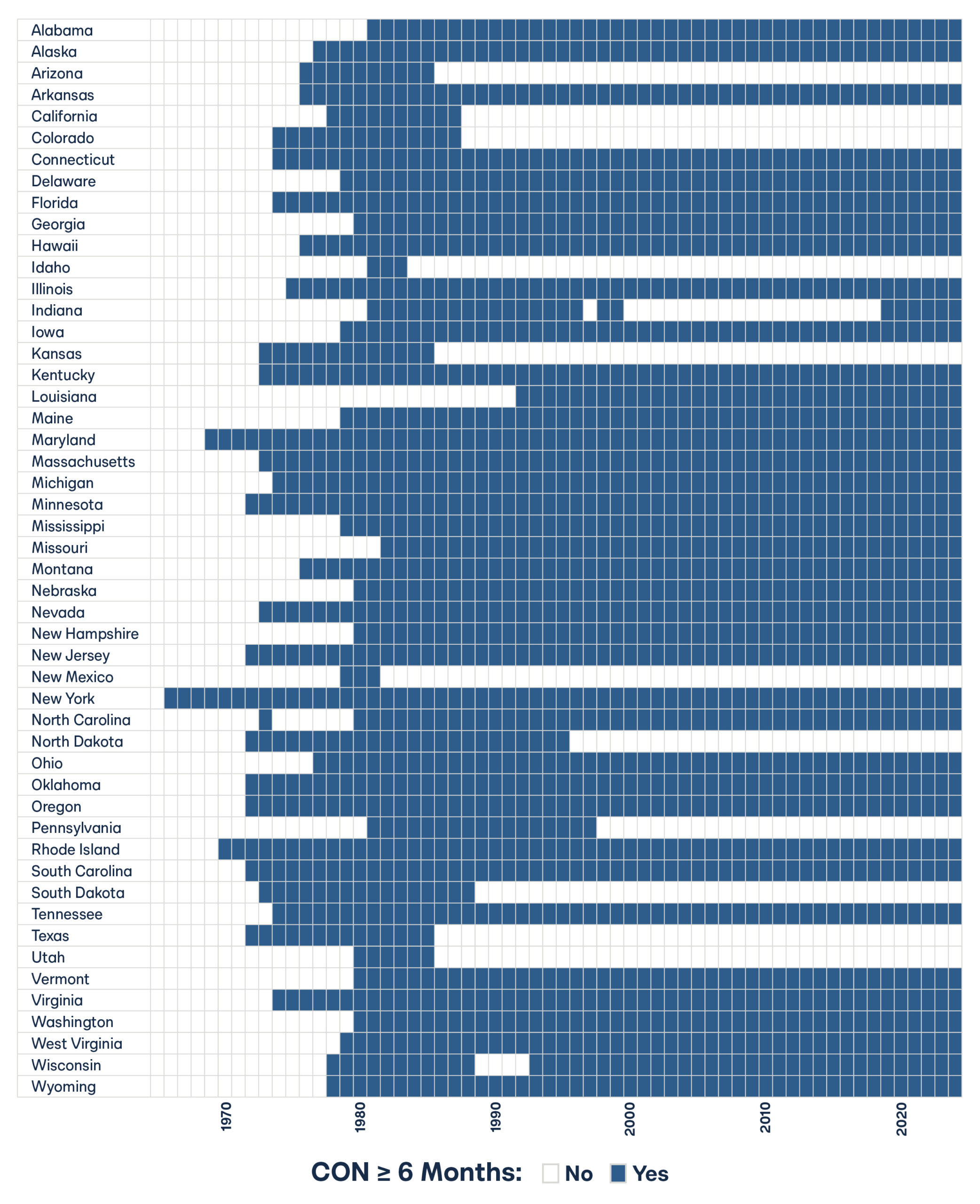
Filling the Gap:
Comprehensive Certificate of Need (CON) Laws Dataset
Certificate of Need (CON) laws require doctors and hospitals to get special permission from the state to open or expand their facilities and service lines, and sometimes even to renew their leases. Incumbent health systems use these laws to limit the entry of new, competing medical facilities and technologies. CON laws limit access and artificially inflate costs, which causes everybody, especially rural Americans, to pay more for healthcare. Nevertheless, 38 states and Washington, D.C., still have CON laws.
Where can I find data on CON laws?
The Mercatus Center tracked CON laws until 2021. The Institute for Justice released a report on CON laws in 2020, and in 2024, the National Academy for State Health Policy (NASHP) published a 50-state scan of CON laws. Each of these resources provides valuable information about Certificate of Need laws, yet they are missing key data.
What is Missing?
The Mercatus Center and the Institute for Justice have key limits. All three datasets do not provide specific dates for CON implementation or data prior to 2000, nor do they always specify the years in which CON laws took effect. To fill this gap, the Cicero Institute created a comprehensive dataset that includes the specific dates for the original passage of CON laws in all 50 states and specific dates for the CON law repeals. If CON laws were reinstated, that is also included along with that date. The dataset is also in an optimal format for econometric data analysis.
Why This Matters
Actionable chronology. By pinning down the exact adoption, repeal, and reinstatement dates for every state, the Cicero dataset turns vague policy timelines into a clean panel of “on” and “off” switches that econometricians can use.
Stronger empirical designs. Exact dates open the door to event-study, difference-in-differences, and synthetic-control strategies that were either impossible or imprecise with the coarse five-year “bins” in earlier resources. Researchers can now trace how CON rules shape prices, entry, and rural hospital survival when they take effect.
Tailored reform playbooks. Lawmakers and advocates can see which states fully repealed CON, which trimmed only certain service lines, and how long reforms survived, helping them craft politically realistic bills instead of one-size-fits-all proposals.
In sum: there’s a single, analysis-ready source that lets everyone move from anecdotes to evidence.
The Dataset
Each row in the dataset corresponds to a single state. If a state’s certificate-of-need law was in effect for six months or more that year, the corresponding cell is shaded.[1] To capture the full legislative timeline (including a brief federal CON mandate later struck down by SCOTUS), the dataset also includes three dated fields to show when CON was first enacted, repealed, and reinstated (if applicable). All dates were drawn from state legislative archives (LexisNexis, HeinOnline), and a notes column flags any additional state-specific details. The map below illustrates this CON landscape over time.
Certificate-of-Need Laws by State and Year

Download Data Files: [csv]
Licensing
The Certificate of Need Laws dataset is released under a Creative Commons Attribution 4.0 International License (CC BY 4.0). You are free to share, copy, and adapt the data in any medium or format, provided that you give appropriate credit to the Cicero Institute as the original source.
Recommended Citation
Cossin, C., Lahue, H., Quandt, R., Richards, M. (2025). Certificate of Need Laws [Dataset]. Cicero Institute. Retrieved from https://ciceroinstitute.org/blog/filling-the-gap-comprehensive-certificate-of-need-con-laws-dataset/.
[1] We treat Arizona and New Mexico as exceptions—where CON applies only to ambulance services—and New Hampshire under its “material adverse impact” regime, which gives hospitals direct approval authority.

Stay Informed
Sign up to receive updates about our fight for policies at the state level that restore liberty through transparency and accountability in American governance.



